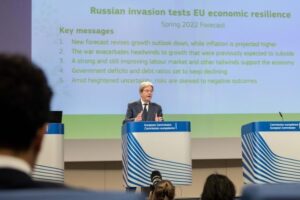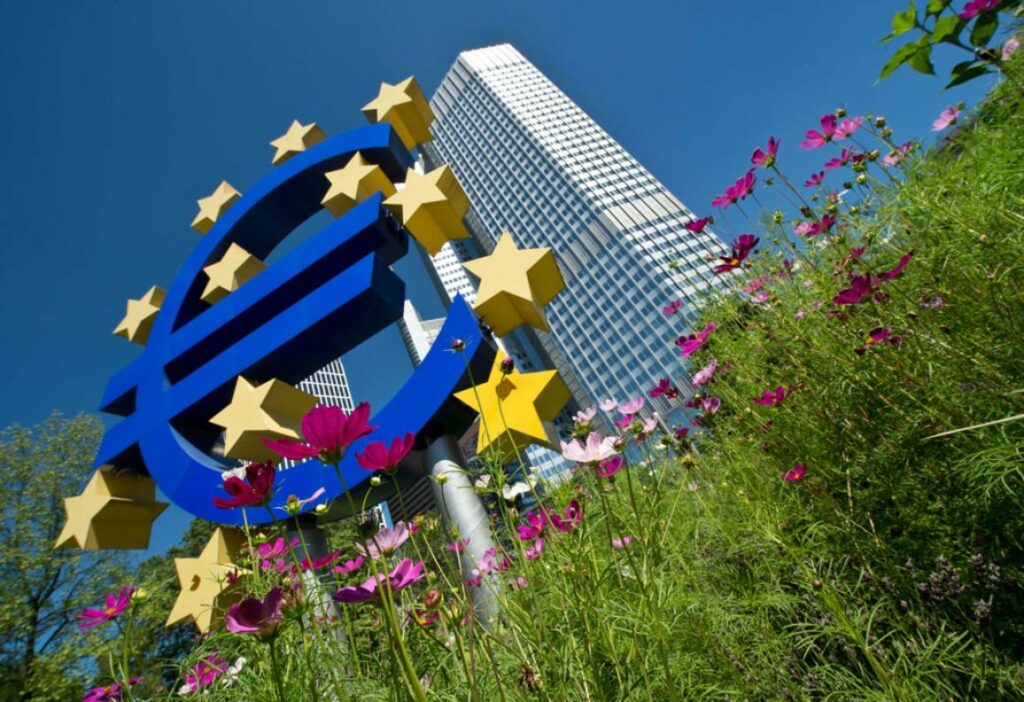Russia's invasion of Ukraine has posed new challenges to the EU economy, just as it had recovered from the economic impacts of the pandemic, according to the Spring 2022 Economic Forecast issued by the European Commission on Monday.
The outlook for the EU economy before the outbreak of the war was for a prolonged and robust expansion. But all this changed since the outbreak of the war. Risks to the forecast for economic activity and inflation are heavily dependent on the evolution of the war, and especially on its impact on energy markets.
By exerting further upward pressures on commodity prices, causing renewed supply disruptions and increasing uncertainty, the war is exacerbating pre-existing headwinds to growth, which were previously expected to subside. This has led the European Commission to revise the EU's growth outlook downwards, and the forecast for inflation upwards.
In the foreword to the forecast, the Commission writes that the uncertainty around the baseline scenario is extreme and the balance of risks is skewed heavily towards unfavourable outcomes. An escalation of the war, a sudden stop of energy deliveries, or a further deceleration of economic activity in the US and China, could result in a much grimmer outlook.
The EU is first in line among advanced economies to take a hit, due to its geographical proximity to Russia and Ukraine, heavy reliance on imported fossil fuels, especially from Russia, and high integration in global value chains.
Large inflows of people fleeing the war – as many as 5 million in the first 10 weeks since the start of the war – pose a further organisational and coordination challenge for the EU.
How uncertain is the forecast? “Uncertainty and risks to the outlook will remain high as long as Russia's aggression continues,” commented Valdis Dombrovskis, Executive Vice-President for an Economy that Works for People. Other scenarios are possible under which growth may be lower and inflation higher than we are projecting today, added Economy Commissioner Paolo Gentiloni.
A senior Commission official referred The Brussels Times to the assumptions in the forecast. “The magnitude of the economic impact of the war is highly uncertain and depends crucially on its duration.”

Economy Commissioner Paolo Gentiloni presenting the Spring 2022 Economic Forecast, 16 May 2022, credit: EC
The central scenario for the forecast of the global and EU economies assumes that the geopolitical tensions will not normalise before the end of the forecast horizon, i.e., until the end of 2023. All sanctions already decided against Russia are assumed to remain in place throughout the forecast horizon.
In the baseline projections, real GDP growth in both the EU and the euro area is now expected at 2.7% in 2022 and 2.3% in 2023. The downgrade for 2022 must be read against the background of the growth momentum gathered by the economy in spring and summer last year, which adds around 2 percentage points to the annual growth rate for this year.
The main hit to the global and EU economies comes through energy commodity prices. Although they had already increased substantially before the war, from the low levels recorded during the pandemic, uncertainty about supply chains has pressured prices upwards, while increasing their volatility.
Inflation has been picking up momentum since early 2021 because of higher energy prices. Inflation in the euro area is projected at 6.1% in 2022, before falling to 2.7% in 2023. For the EU, inflation is expected to increase from 2.9% in 2021 to 6.8% in 2022, and fall back to 3.2% in 2023.
On the positive side, the labour market is entering the new crisis on a strong footing. In 2021, more than 5.2 million jobs were created in the EU economy, which attracted nearly 3.5 million more people into the labour market. In addition, the number of unemployed decreased by nearly 1.8 million people. Unemployment rates at the end of 2021 fell below previous record lows.
Despite the decline in economic growth, labour market conditions are expected to improve further. Unemployment rates are forecast to decline further, to 6.7% this year and 6.5% in 2023 in the EU and to 7.3% and 7.0% in 2022 and 2023 respectively in the euro area.
In a more severe scenario, GDP growth rates would be around 2.5 and 1 percentage points below the forecast baseline in 2022 and 2023, respectively, while inflation would increase by 3 percentage points in 2022 and by more than 1 in 2023, above the baseline projection.
The impact of sanctions
An issue currently discussed in the EU is imposing more sanctions against the import of fossil fuels from Russia. The dilemma facing the EU is how to “maximise” pressure on Russia and “minimize” the economic impact on its own economy while taking into account the concerns of some landlocked EU member states that are more exposed to dependency on Russian oil and natural gas.
This is essentially a political decision where EU member states will have to consider some inconvenience during a transition period and temporary exceptions to some countries to achieve unanimity. In the short-term, diversification away from Russia and fossil fuels more broadly will be costly, according to the forecast.
But benefits of reducing the EU’s energy dependency, especially on Russia, outweigh costs. In the medium term, the substitution of fossil imports with less expensive renewable sources of energy will reverse the terms of trade shock that is currently hitting the EU economy. Capital investments to implement low-emission technologies are expected to spur total factor productivity growth.
The EU is currently discussing a sixth package of sanctions that would, among other measures, ban imports of Russian oil. According to the report, sources of oil imports are assessed to be substitutable due to the relatively expandable production and flexible transportation modes of oil. Substituting Russian oil would be manageable for the majority of member states.
For the full document, including country specific reports on EU countries, candidate countries and other non-EU countries (incl. Russia), click here.
Correction: A previous version of the article stated that the forecast horizon extends until end of 2022.
M. Apelblat
The Brussels Times

